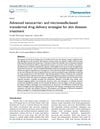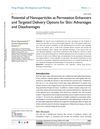Curcumin Grafted Poly(Vinyl Alcohol) for Ascorbyl Palmitate Encapsulation
January 2011
TLDR Encapsulating ascorbyl palmitate in curcumin-grafted particles improves its stability and skin penetration.
The study investigated the encapsulation of ascorbyl palmitate (AP) into curcumin-grafted poly(vinyl alcohol) (Cur-PV(OH)) and cinnamate-grafted poly(vinyl alcohol) (Cin-PV(OH)) nanoparticles. It was found that encapsulated AP was more stable than unencapsulated AP, with Cur-PV(OH) providing greater stability than Cin-PV(OH). The encapsulation efficiency for Cur-PV(OH) was 80.85%, with a loading capacity of 29%. The average diameter of AP-loaded Cur-PV(OH) particles was approximately 269.8 nm. A skin penetration study using pig ear skin revealed that hair follicles were the primary route for AP-Cur-PV(OH) particles to penetrate the skin, and these particles could release AP into surrounding tissue.


